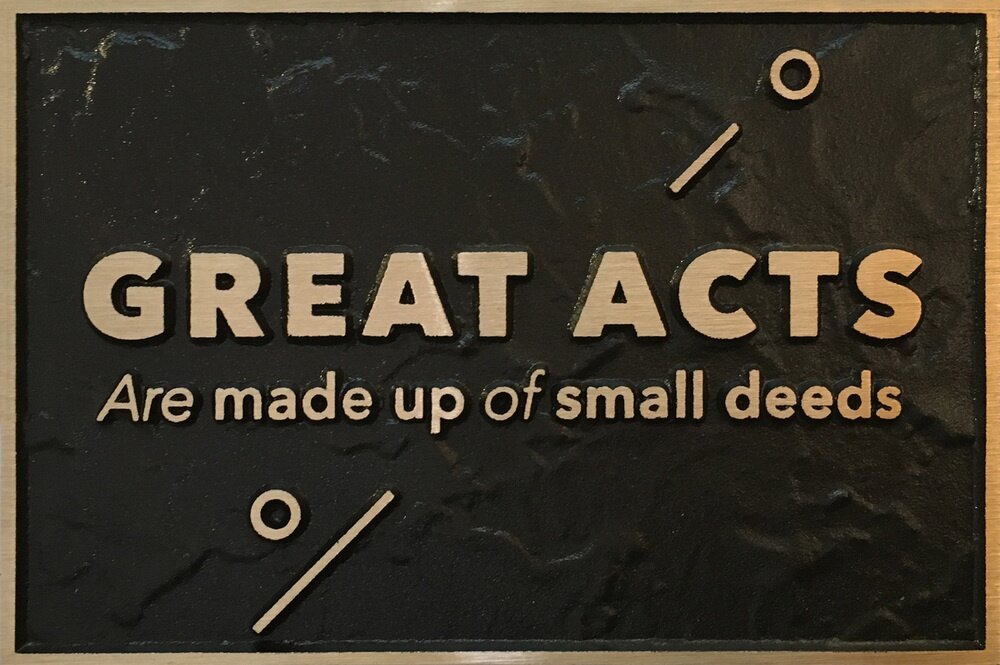December is half way over, and temperatures are in the mid 60’s with sunny days and little wind. Here in Brooklyn, we are cherishing the unusually warm winter weather. All of our last minute winter preparations can be addressed without a rush, giving us an extra week or two to put away those favorite warm weather-clothing items, seal the windows and bring out our slippers. For our clients, this surprisingly warm period also provides a last minute opportunity to prepare their bronze plaques for another harsh winter. We’ve included some valuable information on our bronze plaque winter prep process below.
One of the many benefits of bronze is that it is low maintenance metal. Cast bronze plaques are very durable. They hold up well underfoot and on the wall, indoors or out. However, over time in harsh winter climates, the cold and salty conditions can sometimes begin to show on the surface of the bronze.
Our studio finishes all of our plaques with a clear protective lacquer. This lacquer serves as a sacrificial layer, creating a barrier between the plaque and any graffiti, humidity, salt, rain or snow which can otherwise cause the plaque to oxidize and turn green. Bronze is a metal alloy composed of nearly 90% copper, so left without the protective coat, the metal's coloration will change over time. Many of our clients enjoy the natural patina of bronze, and some even request that we do not apply the clear lacquer to their plaques. This encourages the natural aging process, and the bronze will react and oxidize at a faster rate.
For our clients who prefer that their outdoor bronze plaques remain as unchanged as possible over a period of years (keeping that natural peachy gold hue), we often recommend reapplying a clear coat once a year. The initial clear coat applied in our studio lasts about one to two years; greatly depending on how harshly it has been treated under foot traffic, changing weather conditions, etc.
HOW TO CLEAN AND RE-LACQUER YOUR CAST BRONZE PLAQUE
This process should only be attempted on a good weather day with dry conditions. Reapplying the lacquer finish will ensure that your plaque is protected for the next 6 months to a year. Please note: Re-application of the clear lacquer is an optional process, and is meant as an extra precautionary measure.
CLEANING YOUR PLAQUE:
Many companies will recommend expensive oils and cleaning products used specifically for bronze. In our experience, a mild soap (the plainer the better) and tap water are all you need to clean your plaque. Use a rag or soft toothbrush to loosen any dirt or dust from the surface of the bronze. If there has been any unwanted oxidation on your plaque, we often recommend using a Scotchbrite pad to gently scrub away the changed areas.
Use mild soap and water – Avoid using too much soap, which can leave a foggy residue on the plaque.
Wait for the plaque to dry completely or tamp dry with a lint-free, soft cloth.
Blow away any remaining dust / particles from the plaque.
IMPORTANT NOTE: Never use power washers, or astringent cleaners of any kind to clean metal plaques (i.e. Fantastic, Windex). The protective lacquer and patina can be stripped away by everyday cleaners and power washers. If for any reason the methods above are not sufficient, contact our studio and we can discuss alternative measures to address any damage or unwanted discoloration.
APPLYING THE CLEAR LACQUER:
We can supply a can of clear lacquer for a small cost, which typically will be delivered to you in about one week. The lacquer should be applied in even strokes in three different directions over the bronze (i.e. spray horizontal strokes - let dry, spray vertical strokes - let dry, spray diagonal strokes - let dry.) Depending on the amount of wear the plaque is exposed to over time, it may be desirable to reapply this coating annually.
Make sure the plaque is clean and no dust or particles can be seen on the plaque during the reapplication process.
Let each coat dry completely before applying additional layers of the lacquer.
Apply the spray in three different directions







